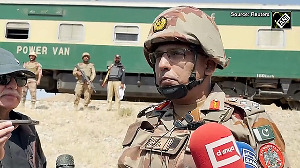Putting behind the post-Pokhran freeze on export of dual use technologies, the United States has inked an agreement with India to substantially boost bilateral high technology trade to further consolidate the strategic relationship between the two countries.
American officials said in New Delhi the Statement of Principles for Indo-US High Technology Commerce signed on Wednesday in Washington by Foreign Secretary Kanwal Sibal and US Under Secretary of Commerce Kenneth Juster was a "breakthrough".
The two sides have been discussing for long cooperation in three key areas of space, high technology and civilian nuclear technology.
The new accord "really engages the issue of high technology across the board. Everything from raising capital to creating new opportunities for Indian and American companies to collaborate and fresh opportunities for cooperation in research," they said.
It was agreed that an Indo-US High Technology Group would be constituted and its first meeting would be convened in the near future.
Indian officials said the agreement represented a significant step in expanding the strategic content of the Indo-US relationship.
The two sides have agreed to take steps to promote and facilitate such trade by addressing systemic barriers, generating market awareness, conducting industry outreach programmes, reviewing policies and processes on export of dual use goods and technologies to India, and pursuing export control cooperation.
The US is of the view that there was immense potential for trade in high technology sector with India, in areas ranging from information technology, biotechnology and telecommunications, the American officials said.
The agreement "places our technology trade in an entirely new foundation which is consistent with the new strategic partnership and reflects an environment of trust and confidence," they said.
In the accord, the two countries have recognised the untapped potential for Indo-US high technology commerce, the need to address economic and systemic issues inhibiting such trade including tariff and non-tariff barriers and the importance of engaging in outreach and trade promotion to Indian and US companies on market opportunities.
It also acknowledges the central role of private sectors in generating increased bilateral high technology commerce.
At the same time, the Statement of Principles took cognisance of the commitment of the two countries to prevent the proliferation of sensitive goods and technologies while emphasising the need for facilitating high technology trade consistent with laws, national security and foreign policy objectives.
The officials said the Memorandum of Understanding signed by the two countries in 1984 was narrow in its approach focusing on high technologies applicable only to military research and strategic programmes.
The latest agreement covers the widest possible areas of dual use technology in both and non-military spheres.
The officials said while the agreement lays down a road map for high technology cooperation, issues like India having access to any specified technology would be dealt with by the joint group.
It conveyed the Bush Administration's intentions to transform Indo-US relations in "very fundamental and far-reaching" ways, they said.
American high technology companies have been interested in increasing their presence in the Indian market but were apprehensive over tariff and non-tariff barriers to entry.
Similarly Indian companies restrained themselves from reaching out to US as they were concerned over restrictions, which, in effect, may not be applicable to them, they contended.
The officials said the two sides were talking of upgrading export controls.
While US sanctions against India in the wake of 1998 nuclear explosions have been lifted, officials pointed out that US was a party to various multilateral regimes and had to abide by its provisions. This included controlling sale of certain technologies.
Two years back, India ranked 28th among the US export markets, well behind small countries like Ireland and the Dominican Republic.






 © 2025
© 2025